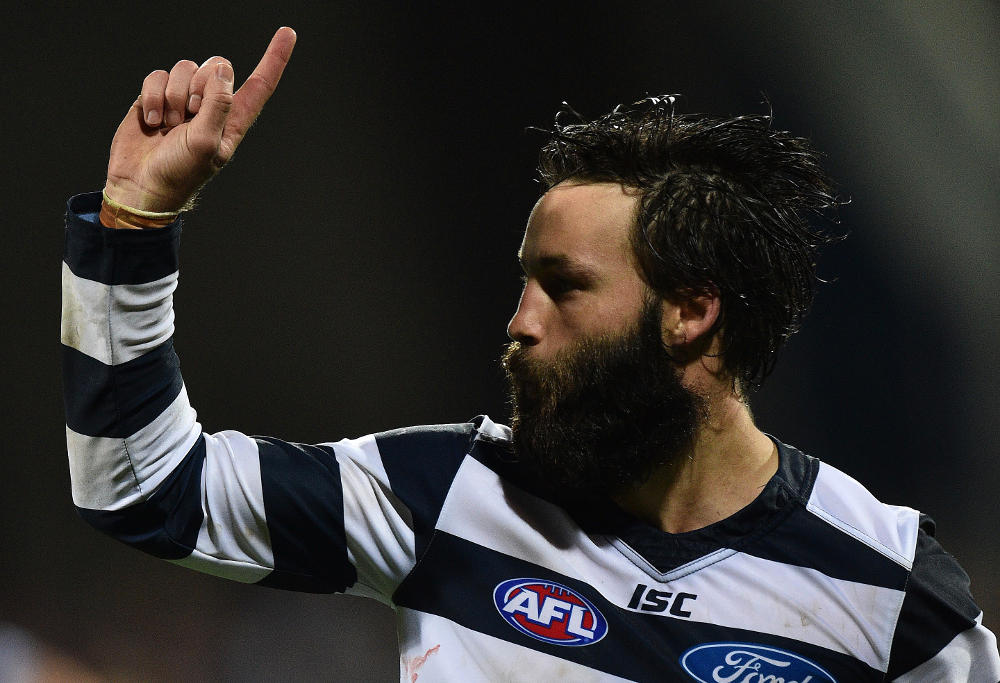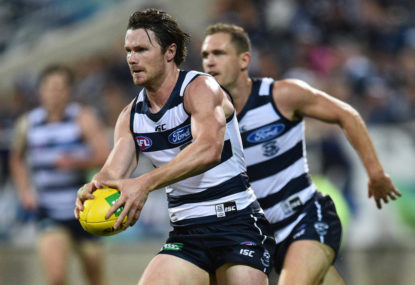With draft season over, the AFL enters the quietest month of the calendar as the year draws to a close. Here’s how that travesty can end, and the league become a true year-round sport.
A typical football season – you know, the one where they play the games and we all scream and shout and have fun and react to things that are happening on the field – runs from the end of March to the last Saturday in September.
Back in the good old days, that was it. Or at least that’s what the folks from the good old days tell us.
These days, the 28 weeks of ‘action’ is bookended by endless pre-season training hype and the pre-season competition itself, in January and February. Also, there is the trade period and the draft in October and November, respectively.
The advent of the AFL women’s league in the first quarter of next year ups the amplitude in the early months, and the fever pitch that player movement reached in 2016 is not going away anytime soon.
What’s the deal? Sports leagues make an increasing share of their dough from commercial deals and advertising exposure, as opposed to gate receipts. The more ‘stuff’ there is to commercialise, the more money gets made – and ‘stuff’ in sports is mostly events and competitions.
For the for-profit codes in this country – and there aren’t many of them – that means more money for their owners. For the not-for-profits, or what you’d call ‘mission’ leagues, more things to commercialise creates money to help propagate their code.
The AFL are notionally the custodians of Australian rules football, even if it sometimes feels like they are a corporate monolith enriching some faceless ownership group in the manner of the NFL or NBA in the United States. A share of the money the professional level of the game brings in is used to subsidise state leagues, junior leagues and to create pathway programs.
The other reason to actively chase the year-round dream is more competitive. There is only so much coverage to go around in the areas of the media that matter, and feeding that journalistic machine with tasty AFL morsels chokes off the supply for other sporting codes. That effect is far more marginal – the Australian cricket team is still the story of the summer – but it exists.

Some prefer the contained nature of the more traditional football-following season. “Wake me up in February” is a familiar refrain on social media around this time of year. But then, large segments of the fan-base can’t get enough #content, and HQ is happy to oblige.
It effectively leaves December as the quiet time, the moment of reflection. Between now and January 1, the only major AFL-related happenings are confirmation of final team lists tomorrow, and a trickle of club financial reports. These appeal to football geeks like me, but not to normal people, and normal people are the majority of football fans.
Most of December sees clubs in pre-season mode, and most will have their full squads on the track. However, there are only so many four-kilometre time trial result stories to be written.
The AFL’s attainment of perennial, year-round league status is a few weeks short of complete.
The x factor
That’s not for want of trying. Earlier in the year, it was reported that the AFL was conducting “secret trials” of a new version of Australian rules football, codenamed AFL X. The game was seven-a-side and played on a soccer field, running for four 10-minute quarters.
Fairfax had direct quotes on the concept from a number of high-ranking AFL officials, including Number One himself, Gil McLachlan.
It dredged up memories from marketing campaigns past.
A sports entrepreneur then came forward and threatened to sue the AFL for stealing his concept, which he had pitched to league bosses.
The punters greeted the concept with three extreme reactions: hell no, hell yes, or history’s biggest collective shoulder shrug.
The Fairfax piece mentions the possibility of the game being played between recently retired players, in an effort to both attract potential fans who hadn’t got into the full Australian rules experience, to fill a hole in the schedule. That’s not a direct quote, but a conclusion from reading the direct quotes.
It marks the latest in a series of rules-based experiments.
The immediate-past example was the ‘lightning carnival’ style pre-season cup fixtures in 2011, which lasted three years before a return to a more traditional format.
At the time AFL X leaked to the media, I was sceptical. Why create a whole new format if you’re trying to attract people to the main game? Don’t cite the Big Bash League or T20 – short-form cricket is addressing a very specific problem with traditional cricket. Playing ‘Australian rules on steroids’ on a smaller field, with one-third of the players, makes no sense in the hottest part of the year.
It’s all well and good to have global ambitions, but one would think the code should be looking after its own backyard before encroaching on other countries’. Recently retired players have recently retired for a reason; will people come out to watch Corey Enright tackle Jimmy Bartel? Actually yes, but that’s not the point. HQ seemed to be making up a problem, then retrofitting a solution.
But let’s not kill this off completely. If filling a hole on the calendar is the main game, the AFL could look offshore for inspiration.

The AFL Summer League
The NBA, the United States’ top-level basketball league, is the very definition of a year-round sport.
It begins in July, with the free agency and trade periods which run through to the start of the season. The regular season begins in late October and runs through April, before a six-week finals series, which culminates in an up-to seven game championship series that wraps in mid-June. The NBA draft is held two weeks later, and the cycle begins anew.
It doesn’t end there. Two weeks after the draft, the NBA Summer League kicks off in Las Vegas.
Summer League is a ten-day tournament, played among most of the NBA’s teams, plus a team made up of players who aren’t signed to a franchise. The teams converge on a couple of gyms in Las Vegas and play a shortened NBA game once or twice a day.
The Summer League serves a number of purposes, but the most important one is as a first chance for teams to show off newly minted draftees to their fans. Teams are able to bring in unsigned players to try out too.
According to reports, it serves as something of a petri dish for the NBA industry, with general managers, scouts, administrators and journalists converging on the event.

If the AFL is looking for a new event to fill the final two weeks of the calendar that need filling, and it is willing to create entirely new sports with loose affiliations to the real thing, the concept of a summer league is worth exploring.
The 18 clubs could converge on a city – let’s be honest, Melbourne – for a ten-day tournament to be played from a Friday to the following Sunday. They could be divided into three brackets of six teams, and play games across the ten days (mostly on Friday, Saturday and Sunday of course) under modified rules, so it can fit snugly into a three or four-hour broadcast window.
Games could be played with fewer players on the ground, or on a smaller field, to guard against fatigue and injury. The fans could come along for minimal consideration, or even for free.
At this time of year, football fans want to see what their new guys have got. Other than time trials and skills drills, there’s no chance to do so until Round 1 – which is a distressing 113 days away. A summer league would give the fans a glimpse of their club’s future, and afford the clubs a chance to introduce their new draftees to the fans. You would think the first to fourth year players would also feature heavily, if not exclusively, in team line ups.
Which is sort of the central point: a summer league is genuine. There’s no need to bring in recently retired players or to modify the rules to make the game more up-tempo. There’s no need to play it on a football field, either.
The AFL needs to ensure it understands what it is trying to do here. T20 came in because cricket as it stood was becoming staid as an engaging sport for large segments of the population, and needed something to generate more appeal. The AFL is simply looking to fill out the final couple of weeks of its year-long calendar. A summer league helps achieve that.
There are some hurdles, sure. It would potentially be played in 30 degree heat – early home-and-away games played in that kind of heat lead to exhausted players. The regular grounds probably won’t be available – although grounds like Kardinya Park and Subiaco Oval would be mostly free. It is far more difficult to integrate new players into an 18-man Australian rules side than a five-a-side basketball system.
Other than the weather, these can be almost fully overcome.
Heat is a problem, but it could be offset by reducing the length of games to compensate; two 30-minute halves rather than four 20-minute, plus time on quarters, for example. There’s no reason the games have to perfectly mirror a regular home-and-away season outing. Games could be played in the late afternoon or early evening, which would help attendance and TV audiences.
There are plenty of grounds that could host the event over a Friday-to-the-following-Sunday schedule. The City of Geelong are always on the lookout for events to stuff into their new stadium, for example. Richmond’s Punt Road would do the trick. Indeed, the tournament could be spread over a couple of the suburban Melbourne home grounds that have hosted or are expecting to host pre-season games.
And to help the new guys integrate into their teams, the AFL could use the league for its science experiments. 16 a side? Why not. 12? Even better! Smaller field? Give it a go. Zones? Hell no, but it’s possible.
Reducing the complexity of the game for draftees and limiting numbers on the field could help create a more attractive aesthetic among teams made up of guys that are just getting to know each other.
It’s no AFL X. There won’t be fireworks or Jimmy Bartel or 70 points in half an hour of play. But that’s the point. If the AFL want to do something to keep our attentions for those final few weeks where there’s nary an AFL story around, why not make it something real and genuine?
































































































